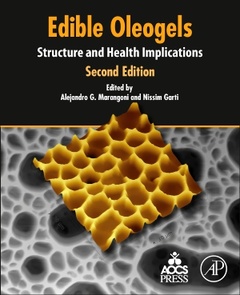Description
Edible Oleogels (2nd Ed.)
Structure and Health Implications
Coordinators: Marangoni Alejandro G., Garti Nissim
Language: English
Subjects for Edible Oleogels:
Keywords
12-HSA; 12-hydroxystearic acid; Alternative oil structuring; Amphiphilic; Appetite; Bioactive; Biocatalytically enabled; Canola oil; Capillary bridges; Ceramides; Cooperative hybrid gelator system; Crystal morphology; Crystallization; Cubic phase; Dietary benefits; Edible application; Edible oil; Energy expenditure; Ethylcellulose; Fat reduction; Fat replacer; Fat replacers; Fatty acyl derivatives; Fatty alcohols; Food products; Fractals; Gel properties; Gelation ability; Gels; Glucose; Hardstock fat; Heat-resistant chocolate; Hexagonal phase; Hybridization; Hydrogen bonds; Hydrogenation; Hydrophilic; Hydroxystearic acid; Insulin; Lipid structuring; Lipid; Lipid-based products; Lipids; Lipophilic; Liquid crystal; Mesophase; Microstructure; Molecular gelators; Monoglycerides; Nanoparticles; Network formation; Nutraceuticals; Octadecan-1-ol; Oil binding; Oil gelator; Oil; Oil-binding agents; Oil-structuring agent; Oleogel application; Oleogel; Oleogelators; Oleogels; Organic acid derivatives; Organogel; Organogelator system; Organogels; Pharmaceutical products; Phase behavior; Physiochemical properties; Powders; Protein oleogels; Protein-oil interactions; Protein; Regioselective enzymatic process; Resins; Rheological properties; Rheological; Rheology; Ricinelaidic acid; Saturated fat reduction; Self-assembled molecules; Shear and cooling rate; Shellac; Stearic acid; Stearyl alcohol; Structural properties; Structure; Substrate utilization; Templated; Trans fat elimination; Triglycerides; Vegetable oils; Wax
470 p. · 19x23.3 cm · Paperback
Description
/li>Contents
/li>Readership
/li>Biography
/li>Comment
/li>
Edible Oleogels, Structure and Health Implications, Second Edition presents a novel strategy on how to eliminate trans fats from our diets. Topics covered include how to avoid excessive amounts of saturated fat by structuring oil to make it behave like crystalline fat and how to develop trans fat free, low saturate, functional shortenings for the food industry. The major approach to form these materials is covered, helping manufacturers incorporate specific molecules (polymers, amphiphiles, waxes) into oil components. As such, this an ideal resource for those in product development and anyone interested in understanding the role of trans and saturated fats in health and nutrition.
In an effort to provide alternatives to trans and saturated fats, scientists have been busy modifying the physical properties of oils to resemble those of fats. Many food products requiring a specific texture and rheology can be made with these novel oil-based materials without causing significant changes to final product quality. Hence, this book provides a valuable resource on new advancements.
1. Oleogels: An Introduction 2. Edible Oil Oleogels Based on Self-assembled b-Sitosterol þ g-Oryzanol Tubules 3. Vegetable Oil-Based Ricinelaidic Acid Organogels; Phase Behavior, Microstructure, and Rheology 4. 12-Hydroxystearic Acid Oleogels 5. Monoglycerides in Oils 6. Wax Oleogels 7. Shellac-Based Oleogels 8. Vegetable Oil Oleogels Structured Using Mixtures of Stearyl Alcohol and Stearic Acid (SO:SA) 9. Stearyl Alcohol Oleogels 10. Ceramide Oleogels 11. Oleogels Based on Nonlamellar Lyotropic Liquid Crystalline Structures for Food Applications 12. Protein Oleogels: Network Formation of Proteins in Hydrophobic Conditions 13. Protein-Templated Oil Gels and Powders 14. Ethylcellulose Oleogels 15. Edible Applications of Ethylcellulose Oleogels 16. Clinical Study on 12-Hydroxystearic Acid Organogel Ingestion 17. The Role of Ethylcellulose Oleogel in Human Health and Its Potential Applications 18. Molecular Oleogels: Green Approach in Structuring Vegetable Oils
Food chemists and those working to find alternatives to transfats in food products
(FROM EDIBLE OLEOGELS)
Nissim Garti obtained his B.Sc., M.Sc., and Ph.D. from the Hebrew University of Jerusalem. He has been a full professor since 1990 and holds the Ratner Chair of Chemistry in the Department of Chemistry and Applied Chemistry. He also serves as a Board Member Elect and Director of the Hebrew University Governors Executive Board since January 2011
- Presents emerging science on beta gels using natural triglycerides, ethylcellulose oleogels, and oleotropic liquid crystals
- Suggests a novel strategy to eliminate trans fats from our diets and avoid excessive amounts of saturated fat by structuring oil to make it behave like crystalline fat
- Reviews the structuring of edible oils to form new mesoscale and nanoscale structures, including nanofibers, mesophases, and functionalized crystals and crystalline particles
- Identifies evidence on how to develop trans fat free, low saturate, functional shortenings for the food industry
These books may interest you

Trans Fats Replacement Solutions 115.88 €

Trait-Modified Oils in Foods 183.61 €


